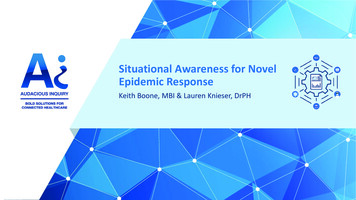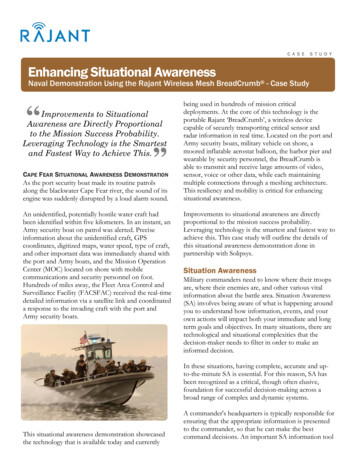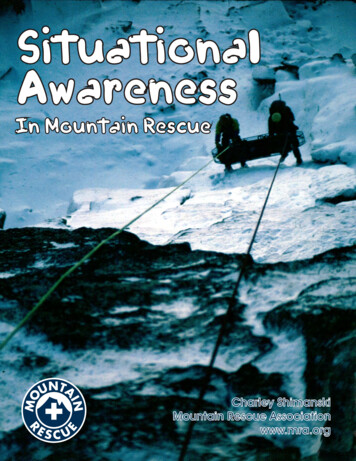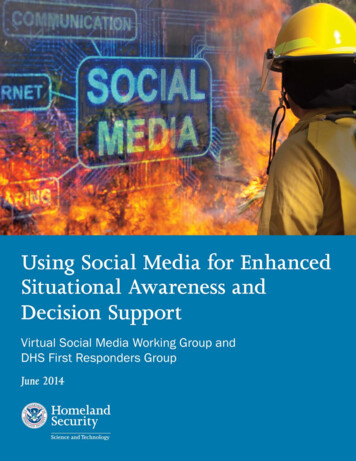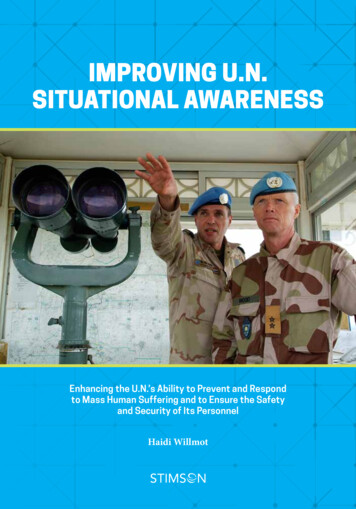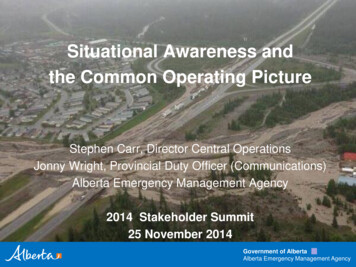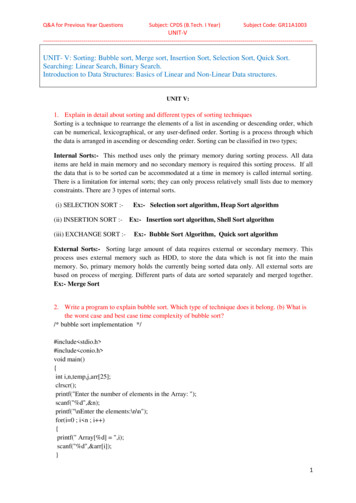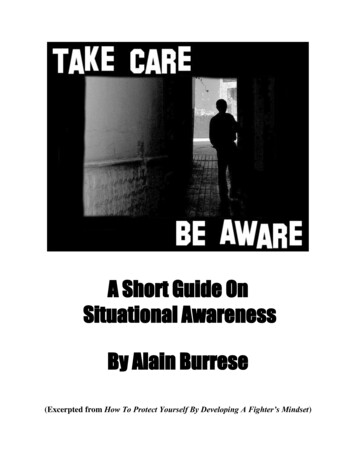
Transcription
Situational Awarenessaka ‘the Bubble’Gary hap5.pdf
USCG Perspective Definition: Situational Awareness is the abilityto identify, process, and comprehend the criticalelements of information about what ishappening to the team with regards to themission. More simply, it’s knowing what is goingon around you. Consequences of Loss: Coast Guard analysis ofnavigational mishaps for cutters and boatsrevealed that 40% were due to a loss ofsituational awareness.
The Endsley Model of SA
‘In the Bubble’All Information, Status, and Cuesare in Agreement. Our Perceptionsand Comprehension Allow Us toMake a Reliable Projections ofFuture Events
Example of ‘In the Bubble’ ILS Past FAF, Cleared to LandLOC and GS CenteredAirspeed Locked On, Gear DownAll B4 Landing Checklists CompletedWX Indicates 500’ Base with 3 sm Visibility300’ B4 our Decision Altitude (DA) Cloud ThinsWhere we can See Ground 200’ B4 our DA we are VFR, Runway In Sight,Aligned Landing Seems Nearly 100% Assured
How Do We Get the Bubble? Planning– Begins on Ground– Route, Approaches, Expected WX, NOTAMs– Chart Supplement and TPP Review Practice– Training– Avionics, Autopilot, System Backups Proficiency– Repetition– Projection
Let’s Pontificate and Share a Bit As Pilots We Must be Active Participants inthe ‘NAS Team’ Pilot A: Immediately Accepts an ATCAmended Clearance Without EvaluatingImpacts to Time, Distance, Fuel, WX, orAircraft Limitations, etc. Pilot B: Receives Amended Clearance;Evaluates; and Either Accepts or Negotiateswith ATC
Losing the BubbleSALoss can beimmediate or gradualbut will leave a trailof clues
Clues to Loss of SA Confusion – Gut feeling that things aren’tright – very reliable since our subconsciouswill detect stimulus before we integrate No One Looking for Hazards – Properassignment of tasks (e.g., monitoringautopilot) Improper Procedures – Prediction ofoutcomes become less certain (e.g. beginningturn before safe altitude on missed approach)
Clues to Loss of SA (cont.) Violating Regulations – Like improper procedureswe are operating in an unknown area (e.g.,descending below an MDA in IMC) Fail to Meet Targets or Goals – We must evaluatewhy we are not meeting them (e.g., above GlideSlope – might be clue as to wind shear ortailwind) Unresolved Discrepancies – Two or more piecesof information don’t agree (e.g., GPS doesn’tagree with VOR)
Clues to Loss of SA (cont.) Ambiguity – Similar to unresolveddiscrepancies, when information is unclear,confusing or missing (e.g., fail to understandamended clearance) Fixation – Preoccupied with one task and failsto detect other important information (Note:It might be outside the airplane, i.e., tower,ground or ATC becoming overwhelmed)
Maintaining the Bubble Address Deviations – Call them out (e.g.,inability to hold altitude in turbulence) Monitor Performance of Others – Be alert forpilot, co-pilot, ATC, etc. errors or slips, speakup! Provide Information – E.g., compulsoryreporting Identify Problems – Not only identify, butanalyze if they will impact missionaccomplishment
Maintaining the Bubble (cont.) Know the Team’s Job – Understanding yourand the rest of the participants in the NAS Communicate Your Course of Action – Keepsall team members informed Be Aware of Upcoming Tasks and ContinuallyAssess Your Readiness – Flight regime isdynamic – must be ahead of the airplane
Faulty Perception Perception is our mentalpicture of reality Example: On RV to anapproach at a unfamiliarairport we think we are Northof the final approach course –in reality we are South– Either our past experience,expectations, or filters ofinformation have left us with afaulty picture of reality
Excessive Motivation Excessive motivation imposes expectationsand filters which affect our ability to assessthe situation. Example: John (a low time instrument pilot) ison an IFR flight with his boss (who is not apilot) to go to an important meeting. Duringthe flight the weather begins to degrade suchthat he will need to fly an ILS approach into anunfamiliar airport close to minimums
Complacency Assuming everything is undercontrol reduces vigilance Example: Enroute at flight level100, George (autopilot) is merrilykeeping you on heading andaltitude as you transit a thickstratus layer. You becomeengrossed in solving the latest NYTimes crossword puzzle. Suddenlythe engine sputters and quits.
Overload Overload – too many tasks,not enough time. Causesdistraction, fixation,omission, increased errors,and high stress. Example: Getting vectored tofinal too high and tight
Fatigue Fatigue impacts vigilance. Ensure sufficientsleep and don’t stretch your duty day.
Poor Communications Level and quality of communications directlyeffects situational awareness.
Humman Errorr
Humman Errorr (cont.) Slips – Incorrectly sending information. Can bevisual or auditory. Example: Tower operator tells you left handturn out. Typically you get a right hand turnout from this runway and respond; ‘Cessna1234, right turn out on course.’ Compoundingthis slip is if the tower doesn’t correct you.Now there are two slips.
Mistakes Mistakes are failures in planning, data entry,or allocation of time. Example: Failure to plan for headwindresulting in low fuel before planned arrival atdestination
Errors Errors are flawed execution; they are incorrectactions based on correct or incorrectinformation Example: Flying alternate missed approachprocedure instead of primary publishedmissed approach.
Situational Awareness – Recovery 101 Confess – Admit to yourself you need help– Difficult to do, but is necessary to ask for help Share and Ask for Help – ATC, Co-Pilot, Instructor,FSS, Passengers– Get the team involved Prioritize – Aviate, Navigate, Communicate– Fly the plane, fly the plane, fly the plane Be Specific––––Know how and when to use:UnablePriorityMayday
Situational Awareness – Recovery 101(cont.) Buy Some Time:– Slow Down– Request Radar Vectors– Request Holding Pattern
Summary of Situational Awareness Dynamic Hard to Maintain Easy to LoseFinally,Highly Dependent on Judgment,Guess I’ll Go Get Some of That!
Situational Awareness – Recovery 101 Confess – Admit to yourself you need help –Difficult to do, but is necessary to ask for help Share and Ask for Help – ATC, Co-Pilot, Instructor, FSS, Passengers –Get the team involved Prioritize – Aviate, Navigate, Communicate –Fly

